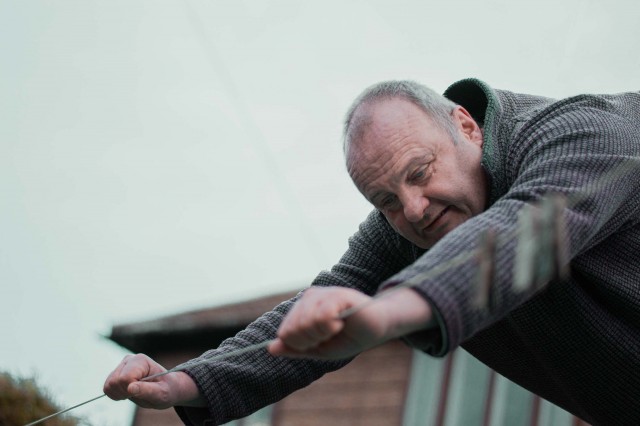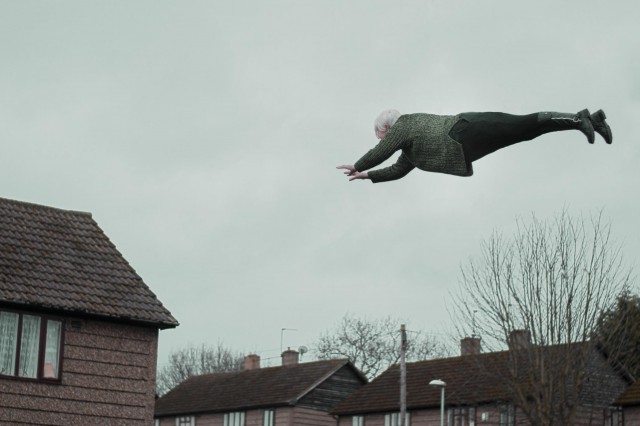Regeneration is a word that seemingly has positive attributes, conjuring up images of restoration and improvement. Yet in the world of housing, it’s a term that for many is associated with hopelessness and despair, with the redevelopment of areas seeing many lose their beloved family homes as those on lower incomes are forced out of their community. Alfie Barker’s inventive 10-minute documentary, Hanging On, is the tale of one such group, as they fight to hold on to the estate that many have called home for decades.
With the 70 properties of Sugar Hill Close and Wordsworth Drive in Oulton (UK) set to be demolished, due to health and safety concerns around their deteriorating condition and sustainability, and replaced with new houses, Barker’s short joins the community at a desperate time in their fight. These people will do anything to cling to their homes, which to them are more than just bricks and mortar. But unfortunately, despite their spirited fight, the system is not on their side.

A resident of the estate is seen clinging on to a washing line as part of Barker’s unique approach to filming his short film.
It’s another example of those without money losing out to those with money and unfortunately, it’s not an isolated case. This particular story may be focused on this one housing estate in the North of England, but here in the UK (and I’m sure all over the world), this is a common occurrence, with incidents reported all over the country. In the documentary field, we’ve seen stories of whole areas affected by the loss of industry (Michael Moore’s Roger & Me being a classic in this sub-genre) and others that have documented similar stories as the one detailed in Hanging On. With this in mind, it was important for Barker to bring a new angle to his film and he does so in its incredible visual approach.
“We needed a visual way that hadn’t been seen before”, the director explains as we discuss bringing originality to a recognisable story. Initially, as we tour the estate, gliding through the houses of the residents, the production is impressive, yet conventional. You may be wondering exactly what this innovative aesthetic touch is…until we begin to meet the locals. Instead of shooting the homeowners as standard talking heads, Barker and his team recorded their interviews and then shot them floating around their neighbourhood, literally trying to cling on to the homes that they love.
“It was immediately met with a lot of apprehension”
“There wasn’t really an amazing moment of where the idea came from but I’d picked the title Hanging On first, then thought ‘wait.. what if they were actually hanging on?’, the director reveals as we question him on how he first came up with this idea. However, having the idea and getting the residents to agree to do it are two different challenges. Like all good documentary filmmakers, Barker had to build the trust of his interviewees before they fully bought in. “We had a bit of a plan to prepare showing the residents the idea, presenting an image on my phone of someone floating saying ‘this might be you’ and it was immediately met with a lot of apprehension”, he explains. Sounds like a reasonable response frankly when a filmmaker you don’t know asks you to be suspended in mid-air, on camera!

“We filmed them suspended as a static shot and then removed both the person and manitou to shoot a clean plate of the same shot”, Barker explains how they achieved the impressive FX in his short film
Barker knew this crazy concept was essential for his film to succeed though and so he persisted. The confidence in his idea finally won the residents over and after reassuring that “it would be ok and that we’re not crazy”, they agreed to follow his lead. Now he was just left to consider how to actually bring this idea of the floating homeowners to the screen. “This had to be shot on that estate, with the residents outside of their homes”, the director reveals and we unravel his production process. With that stipulation any consideration of green screen was quickly dismissed, as they felt filming on the actual streets would have more impact, both on-screen and off-screen. “We wanted it to be a piece of theatre for all the community during a time that was quite bleak”, says Barker.
Thus on-screen VFX was the only option for Barker and his crew, which proved a huge challenge, as they hadn’t done anything similar before. “It was a huge learning curve and meant lots of conversations to educate ourselves a bit and make sure it worked in the edit”, the director shares. “We worked with a highly experienced stunt team led by Justin Pearson who rigged the residents onto a manitou using wires placed on the back, arms, and legs, and we had them dangling in specific areas for a few minutes at a time. We filmed them suspended as a static shot and then removed both the person and manitou to shoot a clean plate of the same shot. Our VFX artist Owain Street then later matched the two shots, erasing the wires, cleaning up the clothing around it and any tricky background elements and then we added a handheld effect to it”.
“They didn’t win but they but they also didn’t lose”
All the hard work that went into achieving this effect was certainly worth it, as it’s hard to see Hanging On making the same kind of impact without its incredible visual approach. It’s more than just an aesthetic gimmick though, these people are literally being ripped from their homes by a faceless entity and Barker has bottled that specific feeling through his ambitious production. Unfortunately, as is often the case, despite the documentary sharing their story at high-profile film festivals, the residents lost their fight to remain in their homes (some ‘protected’ homeowners stayed) and demolition work has begun.
It’s not all doom and gloom though as Barker reveals: “There has been some progress where the council has found a way to prioritise lettings for ex-residents to move back to the estate once it’s been re-developed (with conditions), which I don’t think would have happened without the community’s fight back. They didn’t win but they but they also didn’t lose.”

 Rob Munday
Rob Munday